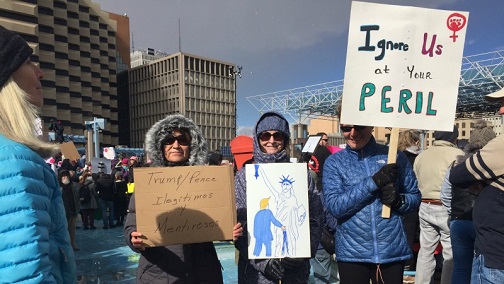(January 21, 2017) Central Maine patients fear weaning off opioids as they struggle with chronic pain
And while patients concerned about medication limits may be able to qualify for exceptions, two of the people interviewed weren’t aware of exceptions and already were being tapered off their medications by doctors. Another said there’s scant information available about how to apply and qualify…
New patients are limited to a dosage amount of less than 100 morphine milligram equivalents, or MME, of opiates, and those already taking medications above the limit must taper to less than 100 MME by July 1…
About 16,000 patients in Maine are prescribed more than 100 morphine milligram equivalents, according to Gordon Smith, executive vice president of the Maine Medical Association. About 1,300 Maine patients are prescribed more than 300 MME.
“Even at 200 morphine milligram equivalents, you have a 1 in 32 chance of dying within the next two-and-a-half years,” Smith said. “That’s a mortality rate that’s very, very high.” …
This sounds like something drummed up by statistics, which the medical industry is relying on more and more. I’m always amazed at how easy it is to bend statistics to your own belief system. Thing is, patients are not statistics, and to think of us that way is a huge mistake.
“I hate having medicine legislated,” said Steve Diaz, chief medical officer for MaineGeneral Medical Center in Augusta. “I believe as a profession we physicians should be policing ourselves and have the wherewithal to provide guidelines. But I think the issue here is the opioid epidemic was getting worse, and there was no national or state medical response to rein it in.”
No national or state medical response? Like, the opioid war? Where the fuck have you been, Mr. Diaz?
Smith, of the Maine Medical Association, said that “help is coming” for those who are tapering off. Nurse practitioners and physician assistants can prescribe suboxone, a narcotic that is used to treat addiction to pain relievers, beginning in February. The Maine Department of Health and Human Services also announced $2.4 million in funding used to create 359 additional medication-assisted treatment slots across the state that began Jan. 1…
Here you see the government’s answer to the epidemic of chronic pain — treat us all like drug addicts. (The stock price for the maker of Suboxone is currently up 13 points. How many of those involved in advocating for the opioid war own stocks in addiction treatments?)
While the use of opioid medication for chronic pain may be common, it’s not necessarily the best form of treatment. A growing body of evidence shows that long-term opioid use actually worsens chronic pain, as well as depression, ability to function and overall quality of life, said Dr. Stephen Hull, director of medical pain management at the Mercy Pain Center in Portland.
“They work very well for dampening down activity of the nervous system in relationship to pain,” Hull said. But the drugs also activate the immune system within the brain and spinal cord, making the brain more sensitive to pain. So although opioid patients experience short-term pain relief, the activation of the immune system results in even higher pain levels as the drug leaves the bloodstream. At the same time, as patients build up tolerance to the drugs, they require higher and higher dosages to feel the positive effects and stave off the heightened pain levels that come with withdrawal…
Dear Dr. Stephen Hull: You’re a dickhead who makes no sense. Are you a graduate of Trump University?
“What we’ve seen at the Mercy Pain Center is that those folks who are willing to come off these medicines succeed at high rates and report not only that their pain is better but that their cognitive functioning is much better,” Hull said. “We’ve come to feel that not only is it appropriate to get under that 100 milligram equivalents of morphine, we are telling our patients that it’s appropriate to get them off opioids altogether.”
Are we in a doctor’s office or a church? Are you a doctor, a priest, or a judge? I feel sorry for your patients, Mr. Hull. How many have left your practice?
Physicians can prescribe opioid medication above the new legal limit for pain related to cancer treatment, end-of-life care, treatment for substance abuse and palliative care. Palliative care, as defined by state law, is patient-centered care that aims to optimize quality of life by anticipating and treating “suffering caused by a medical illness or physical injury or condition.” …
Well, this is new. An exception for the treatment of substance abuse. Is that a nice term for addiction or does the government now consider every chronic pain patient on opioids to be suffering from substance abuse? Does that also mean that every chronic pain patient is also entitled to palliative care? I’ve never been to a palliative doctor, but I’ve heard they exist.
My comment:
Isn’t it funny how doctors say one thing, then patients come along to prove them wrong? After about 10 years on prescription medications to treat intractable pain, I was forced into a cold-turkey detox. That was over 5 years ago. Tell me, Dr. Hull, when will my pain get “better”? Because I’m still waiting.
Since you claim to be an expert in treating intractable pain, your clinic must be having a hard time keeping up with demand. Tell us, Dr. Hull, how many patients have you lost or abandoned since you decided that opioids are not appropriate to treat chronic pain? What’s the annual suicide rate for your patients and how much has it increased within the last 5 years?
Just like it’s stupid and cruel (willfully causing pain or suffering to others) to repeal Obamacare without an adequate replacement, it’s likewise ignorant and barbaric to repeal the use of opioids to treat chronic pain without having adequate replacements. Of course, there’s always a gun, which is now easier to buy than pain medication.
Might as well use the opioid war to start the conversation on the right to die. If doctors refuse to treat my pain, I should have the right to humanely end my suffering. Animals get that right, so should humans.













